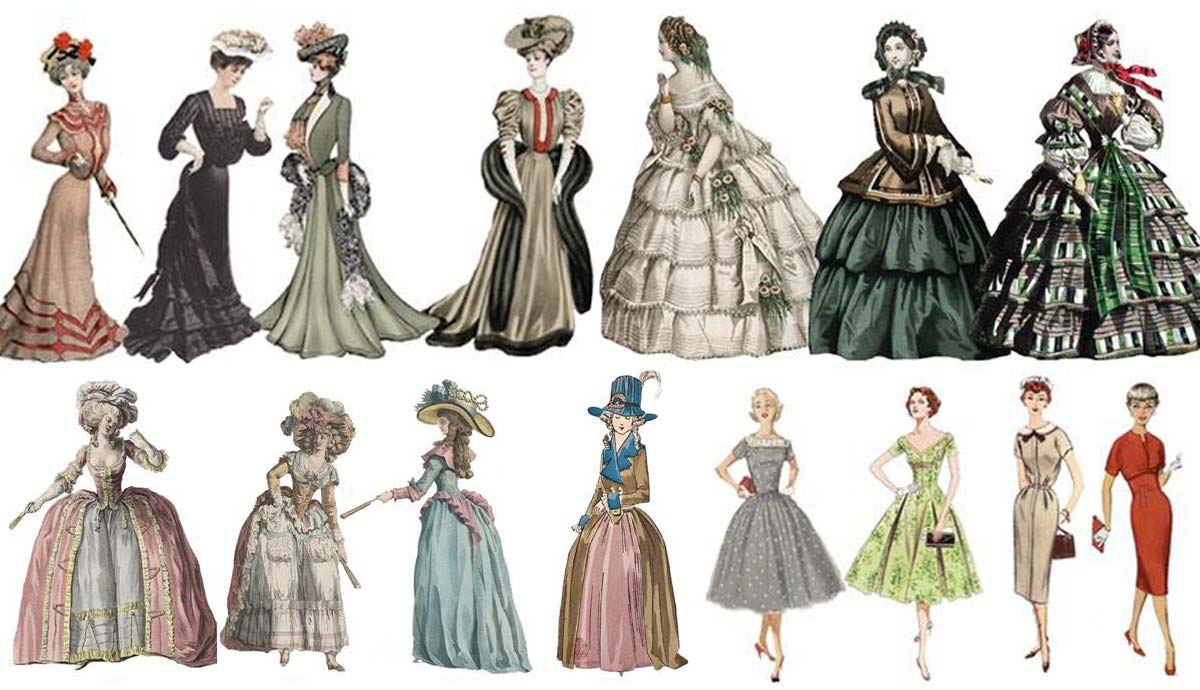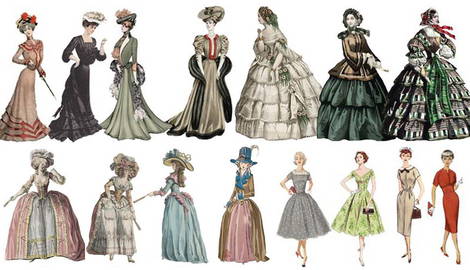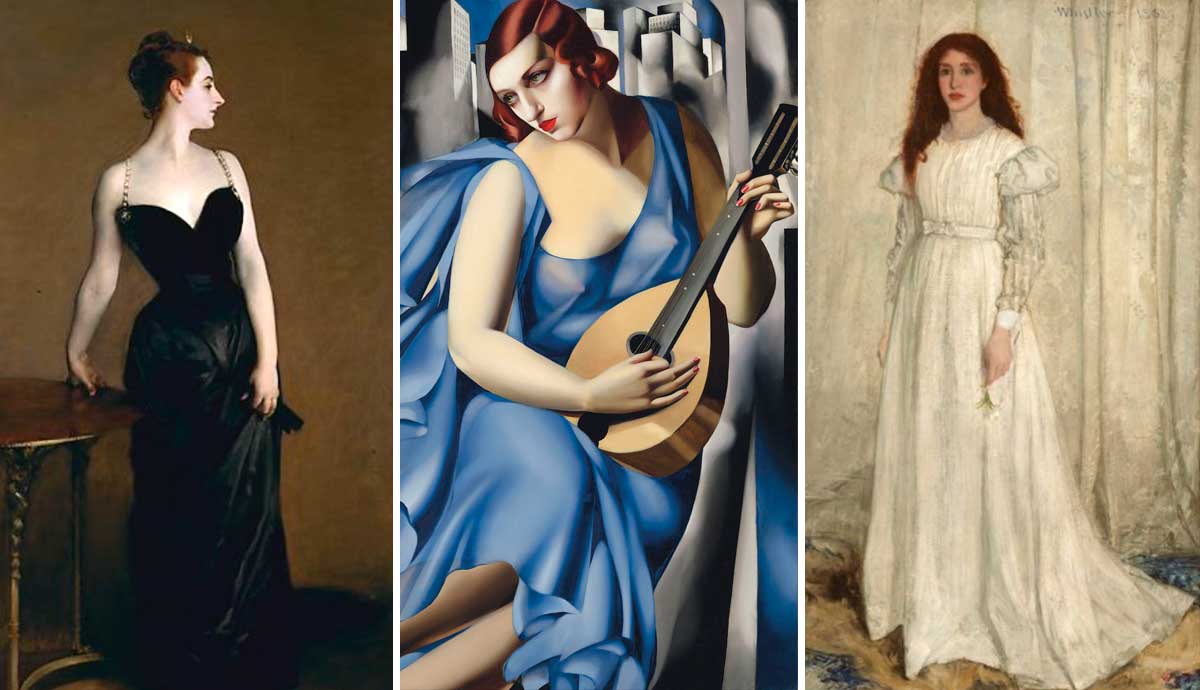
We’ve all fallen victim to older generations who become aghast when you tell them that these jeans are ripped and tattered by design. Fashion trends throughout history have been criticized, whether it be the length of flapper dresses, the height of stilettos, or the high and frizzy hair of the 1980s, but they are trends because of the following they gain, for however short a period. Fashion is a lasting tradition, but trends are often short-lived. What was fabulous five years ago may seem strange to us today, even more so when we look further back in history. Here we will look at 8 trends that live infamously in fashion history.
1. Crinolines

The crinoline, or the hoop skirt, was a form of petticoat that became popular among the wealthy in the 19th century. Victorian women were obsessed with the appearance of a tiny waist, and one way to achieve this was to make a skirt look like an inflated balloon. Crinolines evolved from earlier fashion trends, namely the verdugada or farthingale of Spanish fame and the French panniers, or side hoops, worn throughout the 18th century. The farthingale extended the circumference of the skirt around the waist of the wearer, which made the skirt fall straight down around the structure of the farthingale. Panniers were structurally similar to crinolines, except that they only made the skirt wider around the sides and kept the front and back flat.

Crinolines were initially made of stiff horsehair but eventually were made of thin steel or whalebone to relieve some of the weight and thickness of the traditional petticoat. The larger the crinoline, the more wealth a woman was assumed to have, thus making crinolines impossibly large and seemingly difficult to navigate. Women in the Victorian era had trouble passing through doorways, and gendered chairs came into fashion due to women’s wide skirts. Men’s chairs had arms, and women’s chairs did not because their skirts could not fit between them.
Crinolines were considered a hazard to the wearer because of the fabric’s flammability. Many women chose not to wear flame-retardant materials because they were not as attractive, thus leading medical professionals like Florence Nightingale to believe that up to 630 women died of crinoline fires in a year.
2. Arsenic Dye

Victorian England also saw a trend of brightly dyed fabrics, particularly one invented in Germany in 1814, which made the material a striking “emerald green.” It made the wearer stand out like a jewel among crowds. The only drawback about the color was the ingredients, which combined arsenic trioxide, or “white arsenic,” with copper to make such a vivid hue. It was cheap and plentiful, but the damage to the wearer and the manufacturer were irreversible.
Arsenic dye was used for dresses, shoes, gloves, and even artificial flowers and wreaths with which women used to accessorize. People who came into contact with the dye were exposed to terrible burns and sores wherever the fabric touched their skin. Hair could fall out, and people could even die from the poison if exposed enough. This happened in the case of many manufacturers of the green dye, including a 19-year-old named Matilda Scheurer, whose job was to dust artificial flowers with the pigment. She died gruesomely in 1861, vomiting green liquid, with green fingernails and the whites of her eyes dyed green. After an autopsy on her body, Scheurer was found to have had lethal arsenic in her stomach, kidneys, and liver. British opinion on the dye soured due to deaths like Scheurer’s and led to the development of synthetic dyes that were not made from the rat poison people kept in their houses.
3. Crackowes

Between the 12th and 15th centuries, shoes with long, pointed toes came into and out of fashion. The shoe, the Crackowe or the pike shoe, owes its name to Kraków, the capital of Poland, where the style originated. The shoes were ridiculous; they had to be attached by a chain to the wearer’s legs.
The trend is thought to have been started by nobles in 1382 when King Richard II married Anne of Bohemia, who stylized the shoe. While both men and women wore them, men’s Crackowes were more extravagant, and the toes were made much longer than women’s. Men were considered more wealthy if they wore shoes with long toes and even wore them into battle. By 1465, the shoe was banned entirely in England and France, with the royal edicts disallowing cobblers from participating in their construction. Many thought the shoes fashionable, but others considered them tacky even at the time, as men couldn’t do regular tasks like walking or kneeling for prayer.
4. Chopines

The original platform shoe, the Chopine, was initially worn by women in Venice to help them avoid stepping in mud and dirtying their skirts. However, the shoes soon became a symbol of status. The higher the shoe, the higher the woman’s social class was.
Chopines were worn throughout the 15th, 16th, and 17th centuries and were made by stitching delicate slippers made of velvet or silk onto blocks of wood or cork. In 15th-century Spain, most of the country’s cork supply went into making the shoes of wealthy noblewomen. Many women practiced walking in their Chopines and could walk reasonably well, towering above their peers, symbolically and literally looking down on them.
Chopines were regulated in Venice in 1430, the law stating that the platform could not extend beyond three inches. This regulation was widely ignored, and women continued to wear stilt-like Chopines, sometimes rising to 20 inches high. Women often required two servants to put on the Chopines and needed a team of maids to make sure she didn’t fall while walking.
5. Blackened Teeth

Pearly whites were not always the standard of beauty in society, as hygiene was not necessarily a sign of wealth. Whether dyed or rotted, blackened teeth signified nobility and were even considered beautiful. In Japan, the practice of dyeing one’s teeth black became popular as early as the eighth century, continuing not out of emulation but because black objects were considered beautiful.
Throughout the Heian period, from the eighth to the 12th century, Japanese nobles dyed their teeth black using a mixture called kanemizu, a paste made from iron filings and vegetable tannins. Many male and female nobles began staining their teeth around 15, their black teeth signifying their transition into adulthood. The process of dyeing one’s teeth black was called Ohaguro, and it continued into the Edo period, ending in the 1870s when the Japanese Empire banned the practice. While it may have once been a common practice of nobles, now Ohaguro is only practiced by Geishas for ceremonial reasons.

During the Tudor period, blackened teeth came into fashion because of Queen Elizabeth I, who had a notoriously sweet tooth and a fear of dentists. Queen Elizabeth’s sweet tooth was exaggerated by the sugar imported from British Caribbean colonies. It was a sign of wealth to have sugary dishes at one’s table, along with bad oral hygiene. To make themselves look rich and emulate the nobles, common people in Tudor England dyed their teeth black, hoping to look as though they could afford sugar like the Queen. The nobility rotted their teeth with abandon, preferring to show their status by their ability to afford sugar rather than maintaining white and healthy teeth.
6. Living Jewelry

In 1890s America, a fashion fad came about that mixed pet ownership with animal-inspired jewelry. Live lizards were marketed to women as chameleons that would change color with the wearer’s outfits, providing a matching jewel for every piece of clothing. Women latched onto the idea, putting the small creatures in tiny collars attached to little chains, which would hold them to a brooch, a scarf, or even in the hair of the wearer.
The Society for Prevention of Cruelty to Animals (SPCA) stepped in, arguing that these women were cruel to the lizards, wearing them for pure novelty with no idea how to care for their accessories properly. New York released a citywide ordinance that no more lizards would be sold. People ignored this ordinance, but in 1920, the Humane Society intervened when lizards were still being used as hair brooches. An anecdote of the time went that a girl wearing a chameleon hairpin to a dance accidentally lost the lizard in her date’s mouth as he got too close to her head.
While animal-inspired and filled jewelry was not a new concept, it had roots in Roman and Mayan civilizations. The practice mostly died out in the mainstream by the latter half of the 20th century. Living accessories were traded for more benign insects, like the butterfly clips of 1990s fame.
7. Tudor Ruffs

Today we may be familiar with the ruff, as it still appears in high fashion or costume from time to time. It is one of the most notable fashion trends of the Tudor period in English history, and Elizabethan nobles wore them regularly. Queen Elizabeth I wore ruffs made of imported linen, which framed her face and helped her necklines remain modest. Although the collars were famous, they were also a pain to wear. Ruffs were nearly suffocating, especially if one could not afford to have one made of breathable fabric like linen.
Ruffs began to get thicker and eventually had to be held together with metal framing to keep their shape. While the collar was uncomfortable and impractical, it was a hallmark of the English Court and indicated the wearer’s high status.
8. Hobble Skirts

From 1908 to 1914, a short-lived trend emerged in women’s fashion that greatly limited their mobility and freedom. The hobble skirt referred to any skirt with a slight enough hem to effectively “hobble” a woman by impeding her stride length. When the hobble skirt emerged, women became more physically active, and the skirt was often jokingly called the “speed limit skirt.” French fashion designer Paul Poiret is credited with the invention of the skirt, famously claiming that his pieces “freed the chest and shackled the legs,” as his aesthetic steered away from corsetry and toward slim skirts.

Streetcar lines often offered hobble skirt carriages in the 1910s, which allowed women to board the car without stepping up. While they may have been mobile in this way, the hobble skirt caused many deaths, as it disallowed women the mobility to escape in an emergency. One woman could not dodge a loose horse at a racetrack due to her hobble skirt, and another fell into the Erie Canal after stumbling in the skirt. Hobble skirts lost popularity during World War I when it seemed inappropriate to promote impractical fashions due to the war effort.










